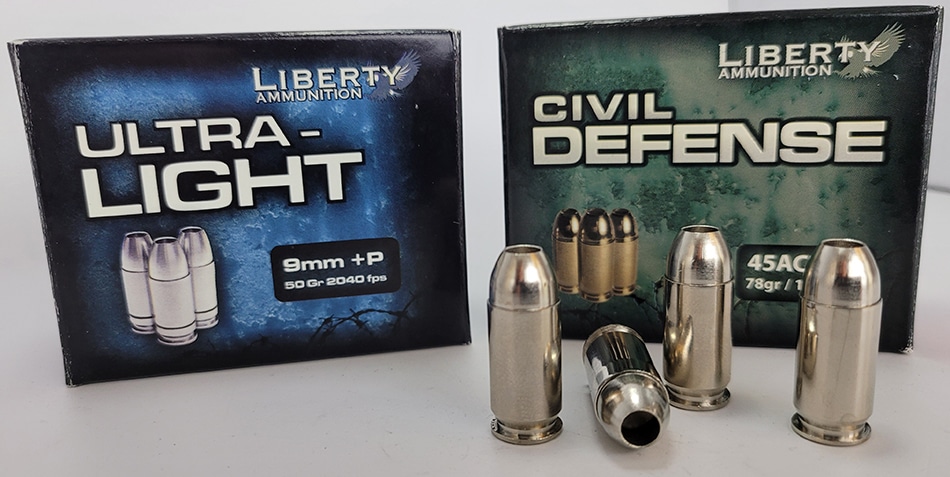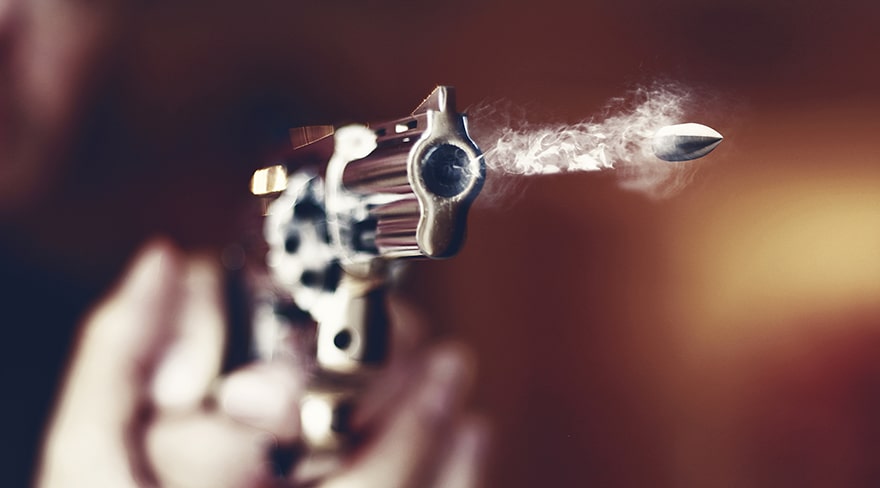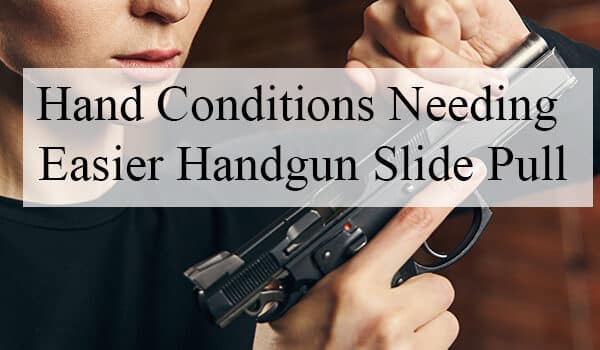A Look into the Concept of Handgun-Stopping Power
If you’ve spent any time at all in the world of firearms, especially handguns, you’ve undoubtedly come across the term “stopping power.” It’s a concept that generates much debate, with strong opinions held on all sides. Understanding handgun stopping power and the factors influencing it will assist you when purchasing a handgun, depending on the desired use.
In this blog post, we will demystify the term “stopping power,” taking you through the science behind it and separating the facts from the fiction. We will examine how various elements like bullet design, shot placement, and caliber affect it. So, grab your ballistic gel and prepare for a comprehensive exploration of “stopping power” concerning handguns.
Table of contents
- A Look into the Concept of Handgun-Stopping Power
- What Exactly is “Stopping Power”
- Factors Influencing Stopping Power
- The +P Ammo Consideration
- Terminal Ballistics
- Calibers Known For Their Stopping Power
- The Ultimate Equalizer: Training
- The Great Stopping Power Debate
- Understanding Handgun “Stopping Power” Conclusion
- Understanding Handgun “Stopping Power” FAQs
What Exactly is “Stopping Power”
“Stopping power” is a term often used to describe a bullet’s ability to incapacitate or ‘stop’ a threat. Despite its frequent usage, there is no universally accepted measurement or standard for stopping power, resulting in much of the disagreement surrounding its use and importance.

Simply put, the idea behind stopping power is that some calibers of firearms or types of ammunition are more effective at halting an assailant in their tracks than others. It’s important to remember that stopping power isn’t solely about lethal force; it’s about incapacitation, stopping a threat as quickly as possible.
Factors Influencing Stopping Power
Bullet Design
When it comes to stopping power, bullet design plays a crucial role. The two main types of bullets typically associated with handguns are Full Metal Jacket (FMJ) and Hollow Points (HP).
- Full Metal Jacket (FMJ): These are the standard bullet type. FMJ bullets are less expensive to produce and, due to their design, are more likely to over-penetrate a target, potentially causing less damage.
- Hollow Points (HP): These are designed to expand upon impact, causing a larger wound channel and thus potentially leading to more tissue damage. Because of their design, hollow points are often associated with higher stopping power.
Caliber and Velocity
The size of the bullet (caliber) and speed (velocity) are other key factors. Larger, faster bullets typically cause more damage and are thus often associated with higher stopping power. However, this isn’t a hard and fast rule, and other factors, such as shot placement, can be equally, if not more, important.
Shot Placement
Even the biggest, fastest bullet won’t be effective if it doesn’t hit a vital area. This is why shot placement often trumps caliber and bullet design regarding stopping power. A well-placed shot with a smaller caliber can be more effective than a poorly placed shot with a larger one. So a strong argument for stopping power is never sacrificing your ability to shoot effectively to go to a bigger caliber.
The +P Ammo Consideration

When it comes to understanding handgun “stopping power,” one crucial consideration is the use of +P ammunition. +P ammo, short for “overpressure” ammunition, offers increased pressure levels, resulting in higher muzzle velocities and improved terminal performance.
This enhanced power can be particularly valuable for self-defense scenarios, where stopping an assailant quickly and effectively is paramount. However, it’s essential to approach +P ammo cautiously, as its increased recoil and wear on the firearm may impact accuracy and longevity. As responsible gun owners, it’s crucial to strike the right balance between firepower and control, considering factors such as personal skill level, firearm compatibility, and the intended purpose of the handgun.
Terminal Ballistics
Understanding terminal ballistics is essential when discussing handgun “stopping power” because it directly relates to how a bullet interacts with its target upon impact. Terminal ballistics encompasses the study of a bullet’s behavior after it strikes a target, including its ability to transfer energy, create wound channels, and ultimately stop a threat effectively. Here are some key concepts related to terminal ballistics and stopping power:

Penetration
A bullet’s ability to penetrate through different layers of tissue and bone determines its effectiveness in reaching vital organs and incapacitating a threat. Proper penetration ensures the bullet reaches critical areas that can disrupt the central nervous system or major blood vessels.
Expansion
Many self-defense ammunition designs include hollow points or other expansion mechanisms. These bullets are designed to deform or “mushroom” to create a larger wound channel upon impact. The enhanced expansion increases the bullet’s effectiveness in transferring energy to the target, leading to better-stopping power.
Temporary Cavity
When a high-velocity bullet impacts soft tissue, it can create a temporary cavity around the wound channel due to the rapid energy transfer. This temporary cavity can cause additional damage to nearby tissue and organs, contributing to stopping power.
Permanent Cavity
The permanent cavity refers to the wound channel the bullet leaves after it passes through the target. The size and path of the permanent cavity depend on the bullet’s design, caliber, and velocity, and it directly affects the damage inflicted on the target.
Over-Penetration
While stopping power is crucial, responsible gun owners must also consider the potential for over-penetration. This occurs when a bullet passes through the target and continues its trajectory, posing a risk to bystanders or property. Balancing stopping power with the risk of over-penetration is essential.
Caliber and Bullet Design
Different calibers and bullet designs exhibit varying terminal ballistics. While larger calibers may create larger permanent cavities, modern bullet designs have improved the performance of smaller calibers like 9mm, narrowing the gap in stopping power between different handgun rounds.
Shot Placement

As mentioned earlier, shot placement remains paramount in stopping a threat. Poor shot placement can minimize the stopping power’s impact even with a highly effective caliber and bullet.
Understanding terminal ballistics empowers gun owners to make informed decisions about ammunition selection for self-defense.
It also provides insights into the dynamics of handgun rounds and how they interact with targets, helping individuals maximize their effectiveness during high-stress situations. However, it is crucial to remember that no caliber or bullet guarantees an instant stop, and training remains critical for responsible firearm use in self-defense scenarios.
Calibers Known For Their Stopping Power
The effectiveness of handgun calibers for stopping power is a subject of ongoing debate among firearm enthusiasts and experts. Different calibers have their pros and cons, and the choice ultimately depends on various factors, including personal preferences, intended use, and individual shooting abilities. Here are five popular handgun calibers for stopping power, along with their pros and cons:
.357 Magnum
Pros: The .357 Magnum is renowned for its stopping power, particularly when using high-velocity loads. It offers excellent energy transfer and expansion, making it effective for self-defense and hunting purposes. Revolvers chambered in .357 Magnum are known for their reliability and simplicity.
Cons: The significant recoil and muzzle blast can be challenging to manage, especially for inexperienced shooters. Ammunition costs can be higher than some other calibers.
10mm Auto
Pros: The 10mm Auto delivers substantial power and energy, making it an excellent choice for self-defense against large or aggressive threats. It offers a flatter trajectory and a longer effective range than many other handgun calibers.
Cons: The recoil can be sharp and potentially challenging to control for some shooters. Ammunition availability might be limited in some areas.
.45 ACP (Automatic Colt Pistol)
Pros: The .45 ACP is renowned for its stopping power and ability to create larger wound channels. It has a long history of use by military and law enforcement agencies, and its relatively low muzzle velocity can help reduce over-penetration concerns.
Cons: The .45 ACP typically has a lower magazine capacity than smaller calibers like 9mm. Recoil can be more pronounced than with smaller calibers, potentially affecting accuracy during rapid fire.
9mm Parabellum (9mm Luger)
Pros: The 9mm is among the most popular handgun calibers worldwide due to its manageable recoil, higher magazine capacity, and widespread availability. Modern self-defense loads offer excellent expansion and penetration, making it an effective choice for many shooters.
Cons: Some critics argue that the 9mm lacks the sheer stopping power of larger calibers, although advancements in ammunition technology have narrowed the gap.
.40 S&W (Smith & Wesson)
Pros: Developed to bridge the gap between the 9mm and .45 ACP, the .40 S&W offers a balance of recoil control, magazine capacity, and stopping power. Law enforcement agencies have widely used it in the past.
Cons: The .40 S&W can have snappy recoil, making follow-up shots more challenging for some shooters. Ammunition costs may be higher than 9mm due to its reduced popularity in recent years.
The Ultimate Equalizer: Training
When discussing “Stopping Power,” training is seldom factored in, but it has a bearing. Training is a critical factor in understanding handgun “stopping power” for several reasons:
- Shot Placement: Regardless of the caliber, shot placement is the most crucial factor in stopping a threat effectively. A well-placed shot to the central nervous system or vital organs is more likely to incapacitate an assailant quickly. Proper training helps shooters develop the skills to aim accurately and effectively under stress.
- Recoil Management: Handguns with significant stopping power often generate more recoil. Adequate training helps shooters learn how to manage recoil effectively, ensuring quick follow-up shots if needed. Proper grip, stance, and shooting techniques are crucial in controlling the firearm during rapid fire.
- Realistic Scenarios: Training should involve realistic self-defense scenarios, which help individuals understand the complexities of using handguns in high-stress situations. Engaging in dynamic scenarios with moving targets and simulated threats helps prepare shooters for real-life encounters, where “stopping power” matters most.
- Psychological Preparedness: Proper training not only focuses on marksmanship but also on mental preparedness. Understanding a life-threatening situation’s physiological and psychological effects can help shooters remain calm, focused, and decisive, leading to more effective responses.
- Legal and Ethical Considerations: Training should also encompass legal and ethical aspects of using deadly force for self-defense. Understanding the laws surrounding self-defense and the use of lethal force helps individuals make sound decisions in high-pressure situations.
In conclusion, training is crucial in understanding handgun “stopping power” by developing shooting skills, enhancing recoil management, guiding ammunition selection, and preparing individuals for real-world self-defense scenarios. Proper training empowers responsible gun owners to make informed decisions and use their firearms effectively and responsibly if needed.
The Great Stopping Power Debate
With so many variables at play, you can see why “stopping power” is a topic of much debate among firearms enthusiasts and professionals. Some argue that caliber and bullet design are the most important factors, while others maintain that shot placement is king. As with most things, the truth probably lies somewhere in the middle.

While larger calibers and certain types of ammunition can increase your chances of stopping a threat quickly, they are not guaranteed. It’s also crucial to remember that no stopping power can compensate for a lack of accuracy. This is why I always emphasize the importance of regular, quality training and practice as a firearms professional.
Understanding Handgun “Stopping Power” Conclusion
The concept of “stopping power” is indeed an intriguing topic. Despite the myths and disagreements, it’s clear that bullet design, caliber, velocity, and shot placement all play essential roles in determining a bullet’s stopping power. However, no factor guarantees immediate incapacitation, and nothing replaces the importance of accuracy and training.
As responsible firearm owners, let’s prioritize understanding the science behind these factors, strive for precision in our shooting, and appreciate firearms’s complex and fascinating world.
Understanding Handgun “Stopping Power” FAQs
While a higher caliber handgun may generally have more stopping power, it’s not always the best choice for everyone. Other factors, such as recoil, manageability, and comfort level of the shooter, are just as important.
No. Stopping power is about incapacitating a threat quickly, not necessarily lethally. While a higher stopping power can potentially lead to more damage, it does not always mean lethal force.
Hollow points are often recommended for self-defense due to their design which can cause more damage, thereby potentially increasing stopping power. However, individual skill, accuracy, and comfort with the ammunition are also important factors to consider.




